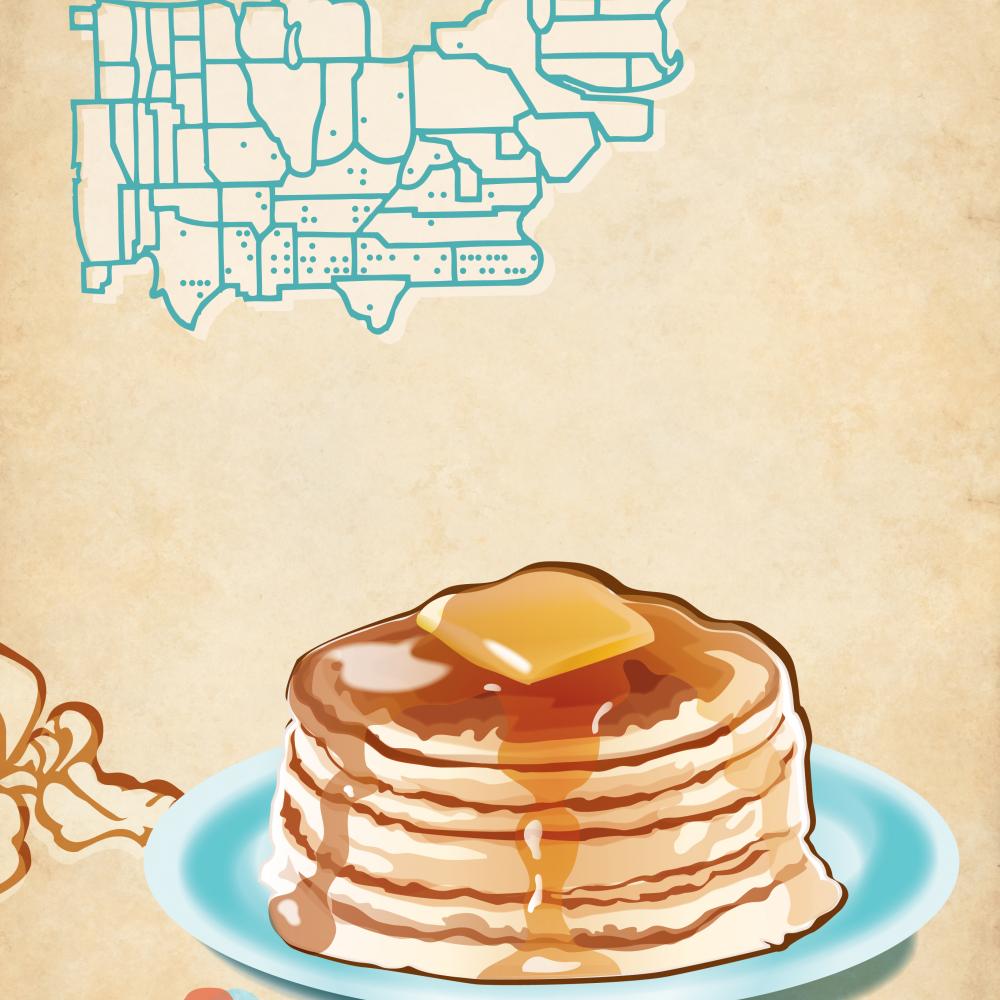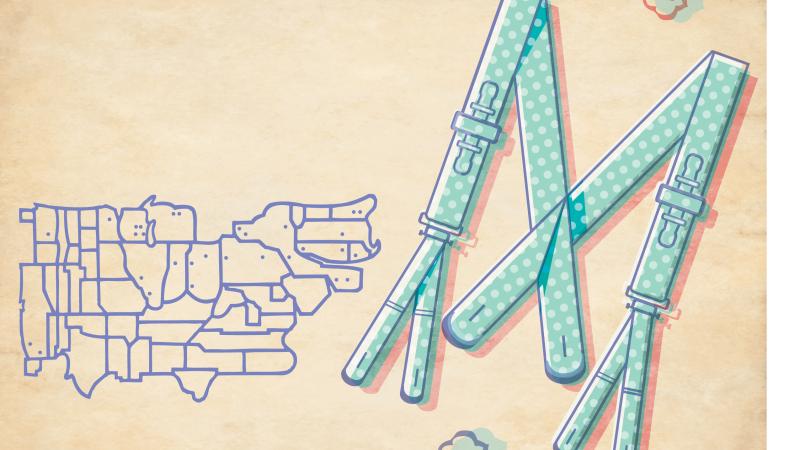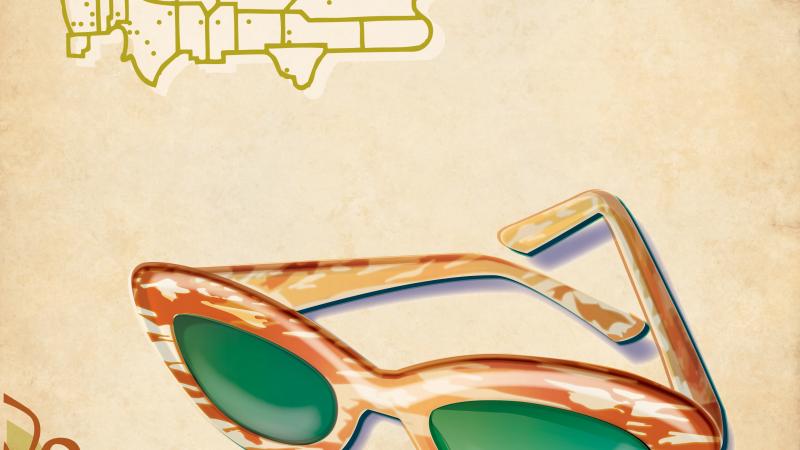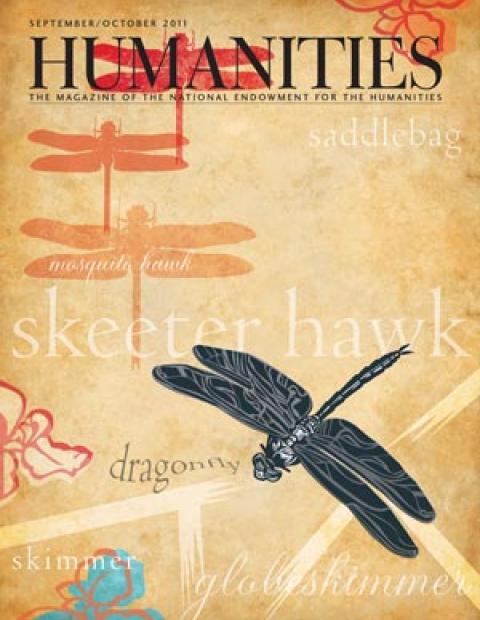The American story is told in American words, the words in journalism, novels, poems, films, diaries, letters, everyday conversation, tweets, and the back-porch tales one generation tells another. Each American word has its own story too, and America has great storytelling dictionaries, historical dictionaries filled with chronologically organized quotations to illustrate the forms, meanings, and uses of American speech. These dictionaries are informative and readable: Anyone with the time and interest can sit for hours in an easy chair and browse American culture word by word. One such dictionary, the Dictionary of American Regional English, covers regional and local speech for the whole United States: It is the treasure-house for the all-American word hoard.
According to this dictionary, a Wisconsin native may know a flower called a maybell, and so may a Michigander, but if they talk flora over a drink in Chicago, it may take awhile before they realize they are, in a sense, speaking different tongues. In Wisconsin, maybell means ‘lily of the valley’; in Michigan, it means ‘marsh marigold.’ The dictionary knows this because fieldworkers surveyed Wisconsin speakers with the question, “What are other names in your locality for the lily of the valley?” and Michigan speakers with the question, “What do you call the bright yellow flowers that bloom in clusters in marshes in early springtime?” Maybell was an occasional answer, a word some of us share that nonetheless underscores differences in how we know and name the world around us.
In the Appalachians, this dictionary tells us, dew poison means “any of various rashes or infections of the feet or legs, believed to be caused by dew; the presumed agent causing such rashes or infections.” Most of the dictionary’s evidence is from Kentucky, but the item was collected in eastern North Carolina, South Carolina, and Arkansas as well. Dew poison, as a quotation in the entry explains, is “ringworm on the feet. Some cases may be hookworm.” A physician from another region might be grateful for the explanation: When patients say dew poison, they are probably talking about what most of us call ‘athlete’s foot.’ The entry also delves into the underlying folk conception: “‘Dew pizen,’ presumably the poison of some weed, which, dissolved in dew, enters the blood through a scratch or abrasion,” which explains why, in the old folk song, a bachelor would keep his lover from the foggy, foggy dew.
Touring the Dictionary of American Regional English is a road trip of the mind from sea to shining sea. Picayune, from French picaillon, meaning ‘old copper coin,’ originally referred to a coin of little value in Louisiana, especially New Orleans. The word is first recorded in 1804. “Near the green,” the dictionary quotes from 1819, “is a horizontal fandango of four wooden horses. . . . Upon these, children canter and circulate for exercise, by paying a half-bit, here called a pécune.” Picayune “belonged” to Louisiana throughout the nineteenth century, but by now, of course, picayune is a more common adjective meaning ‘of little or no account or value.’ It has spread across the country, and the Dictionary of American Regional English locates it in Indiana, Missouri, Arkansas, Maryland, Virginia, New York, and Maine at various points in the twentieth century. Words start out local and, e pluribus unum, sometimes they go national.
Adventures in Lexicography
In March 2012, the Belknap Press of Harvard University Press will publish the fifth and final volume of the Dictionary of American Regional English, familiarly known as DARE, providing an excellent opportunity to reflect on its contributions to dialect research and lexicography. It does not go too far to say that DARE has refined and renewed both disciplines. Its approach has been unusually adventurous. It speaks with authority about American regional speech and has also captured the popular imagination. It is a peerless resource for scholars, but at the same time delivers accurate information about regional vocabulary to laypersons who, until DARE, could not count on access to it. In the twentieth century, DARE was so far ahead of practices in both dialectology and lexicography that it sometimes seemed futuristic.
The American Dialect Society (ADS) was founded at Harvard University in 1889 by many of the same scholars responsible for the Modern Language Association (1883) and the American Folklore Society (1888), led by Charles Hall Grandgent, an instructor at Harvard (later a distinguished professor) whose name is too good to forget. In 1912, Calvin Thomas, then president of ADS, wrote that the society “was organized for the purpose of making a careful study of the characteristics of the spoken English of the United States and Canada, and incidentally of the other non-aboriginal dialects spoken in the same countries.” But as Louise Pound—professor of English at the University of Nebraska, one of the original editors of the journal American Speech, later president of ADS, and even later president of the Modern Language Association—surmised in 1952, there was a more specific object. “Running through the Proceedings of the Society from the beginning and throughout the whole of its existence, as a sort of theme song, is its yearning to publish a dialect dictionary.”
After several decades of mixed and largely undirected activity, a plan and method to make such a dictionary were devised by Frederic G. Cassidy, a professor of English at the University of Wisconsin, who was appointed editor of the society’s dictionary in 1962. DARE is the result of Cassidy’s ingenuity and will to succeed where preceding editors had foundered. “The acronym ‘DARE’ was no accident,” Cassidy insisted. “It expressed the hope that the longtime goal of the Society would at last be reached. We toasted the new title and the project on the University’s Union Terrace in good Wisconsin beer.” A formidable scholar, Cassidy was also an irrepressible word-history raconteur: He was always picking up a word someone had used and telling an interesting story about it. DARE fused the integrity of his scholarship with the pleasure he took in words, a pleasure he never failed to communicate, whatever the audience.
Cassidy saw the first three volumes of DARE into print: Volume I (introduction and A–C) in 1985; Volume II (D–H) in 1991; and Volume III (I–O) in 1996. After he died on June 14, 2000, Joan Houston Hall, named on the title pages of Volumes II and III as associate editor, took charge of the project, publishing Volume IV (P–Sk) in 2002. But even in Cassidy’s later years, she had led the daily work of making the dictionary. Less flamboyant than Cassidy, she shares his commitment to the highest scholarly standard and has demonstrated the patience and sometimes steely determination necessary to keep a multivolume dictionary project funded and on schedule.
Calvin Thomas observed the central role of dialect or, more broadly, variation in language structure and history: “Most persons are prone to look upon these variations simply as the errors of the ignorant—‘bad grammar’ to be avoided, ‘bad usage’ to be suppressed. The truth is, however, that these variations represent one of the most important groups or classes of facts on which the scientific study of language rests.” The significance of dialects was established long before the founding of ADS, by the New Philology of Rasmus Rask, Franz Bopp, Jacob and Wilhelm Grimm, and others in the early nineteenth century. That movement initiated comparative historical linguistics, which articulated relations among extensive language families beginning with Indo-European. William Dwight Whitney, one of the founders of ADS, was America’s preeminent representative of this discipline at the time.
Dialectology thus developed alongside historical comparative philology and historical lexicography. In 1876, Georg Wenker (1852–1911) sent a set of forty passages of literary German to some 50,000 schoolteachers and asked them to translate them into the local dialect. Nearly all the teachers responded (44,251), and Wenker plotted some of the data onto maps in Sprachatlas das Deutschen Reichs, the first linguistic atlas, published in 1881. This pioneering research on German dialects was continued by Wenker’s assistant, Ferdinand Wrede (1863–1934), who saw the first volume of the Deutscher Sprachatlasinto print in 1926.
Wenker’s work led by example to Jules Gilliéron and Edmond Edmont’s Atlas Linguistique de la France, published in nine volumes from 1902 to 1910. Gilliéron and Edmont elicited their data by a novel and influential method: They constructed a questionnaire of nearly 2,000 items that Edmont, an avid bicyclist, administered to bemused speakers around France. Lexicographical interest in dialect grew simultaneously and alongside that of linguistic geography, two branches from the same New Philological root. The English Dialect Society was founded in 1873. The eighty or so glossaries of local words published under its aegis were a central component of Joseph Wright’s six-volume English Dialect Dictionary, published in parts between 1898 and 1905.
The first North American dialect survey was conducted in 1896, through the mail, by George Hempl, then a professor at the University of Michigan. His questionnaire included about seventy-seven items, the most famous of which provides evidence for the greasy/greazy line between northern and southern speech. According to Richard W. Bailey, himself a dialectologist and lexicographer, “Hempl’s materials provide a historical snapshot of American speechways, and it is quite a good photograph when we judge its results against the findings of more thorough and ‘scientific’ research conducted by his successors.” Later dialectologists may have criticized his work as crude, but “Hempl set the agenda for future work. His idea was a simple one: respectful attention to the English language.”
Cassidy knew Hempl’s work, of course, but Hans Kurath and the project he led, the ambitious Linguistic Atlas of the United States and Canada, was the more immediate and significant influence on DARE. The atlas project was planned in meetings of the Present-Day English section of the Modern Language Association throughout the 1920s, prompted by recent publication of the French and German atlases. New England was chosen as the region to pilot the program, and fieldwork on the basis of a questionnaire began there in 1931. The Handbook of the Linguistic Geography of New England by Kurath and his colleagues appeared in 1939, followed by three volumes of the Linguistic Atlas of New England (LANE).
The LANE questionnaire included 750 questions, and fieldworkers asked all of them of 416 informants, representing 213 New England communities, eliciting 312,000 bits of dialectal information. Informants were asked a question that would elicit words like wasp, hornet, or yellow-jacket; by locating responses on a map, one could see where the waspusers lived versus the hornet users, etc. The maps were marked with isoglosses, which are lines supposedly indicating a boundary of usage brought into relief by the plotted bits of data. By bundling isoglosses, it was supposed, one could reliably identify dialect areas and confirm an inventory of terms, pronunciations, and other features (double negation, for instance) associated with one dialect rather than another.
Cassidy intended to produce a historical dictionary of American regional English, but he also wanted to represent the current state of regional usage. He wrote, “The aim was to determine which words and phrases now used by speakers of American English were limited geographically to broad or narrow regions, to smaller localities, and even to single communities or groups of speakers.” Eventually, Cassidy and his colleagues administered a survey of 1,847 questions (more than twice as many as in the LANEquestionnaire) to informants from 1,002 communities across the country. Devising and conducting such a survey is a formidable task, and Cassidy, with the help of his student Audrey Duckert, wisely ran a pilot program, the Wisconsin English Language Survey (WELS). Like its predecessors, WELS depended on a questionnaire; Cassidy and Duckert had recourse to the mail, perhaps because, for most of the year, Wisconsin cannot be comfortably traversed by bicycle. The WELS material—some 90,000 questionnaire responses, including those identifying maybell as a synonym for lily of the valley—was ultimately absorbed into the DARE database.
Afterward, Cassidy and Duckert completely rewrote the questionnaire for DARE. But, as Cassidy later reflected, “What questions would it contain and on what principle should they be chosen?” Approximately 40,000 items that had already been collected and published in Dialect Notes and the Publication of the American Dialect Society were analyzed. Cassidy and Duckert then abstracted forty-one categories, covering words for concrete items and activities of everyday life as well as words reflecting attitudes, feelings, and opinions. They also devised open-ended questions to elicit words and phrases relevant to the categories: “What are names for a sloping outside cellar door?” “What do you call the kind of owl that makes a shrill, trembling cry?” “What games do children play around here, in which they form a ring, and either sing or recite a rhyme?” “What are some joking or uncomplimentary names for lawyers?” and 1,843 others.
The open-endedness is an important innovation in dialect research. In previous efforts, salient features were assumed by the questions. As Cassidy put it in 1973, “the Atlas was set up to determine the geographical distribution of a series of alternate terms already known to vary” (emphasis mine). The editors of LANE knew that people would use either bucket or pail and that an isogloss would depend on the distribution of that choice. Kurath was an arch-empiricist, but DARE’s method, which collected material hitherto unknown as dialectal evidence, was yet more empirically “pure.”
With that open-ended questionnaire, designed to elicit the details of regional speech throughout America, eighty fieldworkers, mostly graduate students, hit the road in 1965. “The first few,” Cassidy reflected, “were sent out in campers that we called ‘Word Wagons,’ though one classically inclined colleague dubbed them ‘Logomobiles.’ But these proved too comfortable; production was slow; we had to go to a ‘piece-work’ system, paying a fixed sum for each questionnaire satisfactorily completed.” By 1970, the questionnaires were collected and it was time for editing to begin; one basis for each entry of the dictionary was the mass of 2,500,000 questionnaire responses collected in the field.
Linguists and lexicographers have long been suspicious of isoglosses. They are a convenient, graphic result of the data, but they are an abstraction far removed from the data. They overgeneralize. And they overparticularize, as dividing lines tend to do: Dialects rarely change suddenly; they change gradually and continually. Isoglosses may not be “wrong,” but they operate at one scale, and dialect can be observed at various scales. Cassidy avoided isoglosses and mapped his data quite differently from linguistic atlases: “DARE’s regional areas inductively discovered do not have sharp outlines but thin out at the edges or merge with other features. The core of a regional area shows frequent or concentrated usage—on DARE maps, close clusters of responses. Thus clustering is taken as the measure of regionality.” Someone unexpectedly confronted with a DARE map would not immediately recognize it as a map of the United States. The size of the states is determined by population and settlement history, “hence the informant distribution, which is relevant to language use as mere area is not.” DAREliterally reconfigures America as no other dialect geography had ever dared to do.
Computers Provide Defining Moment
The maps depend on a pioneering use of computers. As Cassidy wrote, “The planners of DARE had realized from the first that the mass of data would be large and that computer processing must be considered. In 1965, however, though numerical computing was well advanced, the handling of alphabetic material was only beginning.” Cassidy was perhaps the first lexicographer to integrate computation fully into a dictionary project’s production process, first and foremost to manage and manipulate data efficiently and effectively. His example, and his willingness to share his experience with others, has been influential, to say the least: It initiated changes in lexicography and in the methods of humanities research more generally.
Cassidy quickly realized that computers have other than alphabetic uses. Computers easily generate graphic displays with as many fields as necessary into which a dot can be inserted to indicate a particular word or phrase used by an informant. If all informants used a word, there would be a dot in every field, but where usage varies with dialectal synonyms, only certain fields would be filled. With the power of the computer at hand, Cassidy wrote in 1977, “one can display in a few seconds the distribution of any response—a mapping capacity which one would never attempt by manual methods because it would be intolerably tedious and slow.” As a result, the collection of DARE maps presents us with a much more fine-grained account of American regional words and phrases than any previous dialect geography and a more accurate visual account of their distribution.
But even more effective mapping cannot quite bring linguistic geography down to a human scale. As Louise Pound concluded, “Workers for the American Atlas record with scholarly vigilance the speech of the regions they canvass, endeavoring to preserve faithfully for posterity our twentieth-century regional distinctions; yet their results are no substitute for an exhaustive dialect dictionary.” That is because, as Jacob Grimm put it, “every word has its history and lives its own life,” a sentiment that leads inevitably to a historical dictionary. As Cassidy acknowledged, “It should be obvious that the model for DARE was the Oxford English Dictionary, with some innovations, chiefly the use of maps and oral data specially gathered throughout the country in a single five-year period.” The modesty of “some innovations” belies the importance of the maps and oral data.
The typical DARE entry includes elements one finds in all historical dictionaries: variant forms and alternate spellings; pronunciations, when they aren’t transparent; etymologies, when they can be responsibly proposed; definitions and quotations starting with the first known recorded use of the term. Labels describe distribution; for instance, bank barn in the sense of “a barn built into the side of a hill, affording entrance on at least two levels” is labeled “chiefly, PA, OH, MD, VA, IN. See Map.” For bank barn, the map shows outliers in New York, Illinois, Missouri, and Minnesota. Only five informants in Indiana supplied bank barn; west of Ohio, use of it “thins out.”
Another feature that sets DARE apart is its unprecedentedly pluralist approach to evidence. The OED and some related dictionaries rely almost exclusively on quotations from printed texts. Their entries have a certain sheen; differences among sources are subtle. In the English Dialect Dictionary, Wright relied on material collected by the English Dialect Society and his own field research, but not on printed sources. While the texture of entries in Wright’s dictionary is different from that of OED entries, it similarly offers readers a “smooth” reading experience.
By contrast, DARE entries have a homespun texture, demanding more of a reader, who must reconcile various types of information in order to understand what DARE has to say about a word or phrase. But if they pay attention, readers come away marvelously informed. A DARE entry might include any combination of quotations from regional literature, diaries, small-town newspapers, material from WELS, the various linguistic atlases (published and unpublished), other accounts of dialect in scholarly literature, substantial personal collections donated to the project by scholars at the ends of their careers (like the Gordon Wilson collection, from which DARE illustrated dew poison), and, of course, questionnaire responses, identified by informant, so that the curious reader can refer to the “List of Informants” to discover his or her community, community type, year of birth, level of education, occupation, sex, and race—all types of information that can be overlooked in other historical dictionaries, but not in a twenty-first-century dictionary of American regional English.
DARE is a bold synthesis of linguistic atlas and historical dictionary. Until Cassidy proposed to do it, no one had imagined such a work; until it was published, many sociolinguists and lexicographers doubted Cassidy could bring it off. But when the first volume appeared, it was a revelation. As Walt Wolfram wrote in American Speech in 1986, “As ambitious a task as DARE has been, the first volume has exceeded expectations. I say this, not as a party-line ADS member who feels constrained to give a loyal endorsement, but as a repentant skeptic who more than once wondered if this long-promised work would ever be delivered . . . seeing the scope of the entries, I now understand why it was so long in the making.”
In DARE, Cassidy reconceived dialectology and simultaneously introduced a new variety of historical dictionary. It was, perhaps, a typically American improvisation, or an example of New World unconventionality aimed at Old World canons of authority. What seemed a revelation in 1985 will seem no less so next March, when the promise of DARE is fulfilled by publication of its final volume. Scholars of American language, history, and culture will rely on it, and they will enjoy it as much as lay readers. DARE teaches us about American regional speech, of course. It also teaches us to think big, put aside assumptions, draw on traditions when useful, and make things new. It says to us: Whatever transformative project in the humanities you may have in mind, dare to do it.




